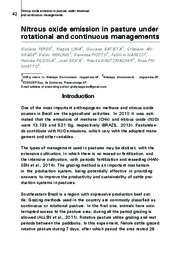Nitrous oxide emission in pasture under rotational and continuous managements.
Nitrous oxide emission in pasture under rotational and continuous managements.
Author(s): PERES, G. R. P.; LIMA, M. A. de; BATISTA, G. das G.; ANDRADE, C. A. de; HERLING, V. R.; PIOTTO, V. C.; NAREZZI, F.; FILIZOLA, H. F.; SILVA, J. A. da; FRIGHETTO, R. T. S.
Summary: Abstract: One of the most important anthropogenic methane and nitrous oxide sources in Brazil are the agricultural activities. In 2010 it was estimated that the emissions of methane (CH4) and nitrous oxide (N2O) were 13,133 and 521 Gg, respectively (BRAZIL, 2013). Pasturelands contribute with N2O emissions, which vary with the adopted management and other variables. The types of management used in pastures may be distinct, with the extensive cultivation, in which there is no reseed or fertilization, and the intensive cultivation, with periodic fertilization and reseeding (HANSEN et al., 2014). The grazing method is an important mechanism in the production system, being potentially effective in providing answers to improve the productivity and sustainability of cattle production systems in pastures. Southeastern Brazil is a region with expressive production beef cattle. Grazing methods used in the country are commonly classified as continuous or rotational pasture. In the first one, animals have uninterrupted access to the pasture area, during all the period grazing is allowed (ALLEN et al., 2011). Rotative pasture utilize grazing and rest periods between the paddocks. In this experiment, Nelore cattle grazed rotative pasture during 7 days, after which period the area rested 28 days, totalizing a cycle of 35 days at the paddock. Mensuration of nitrogenous gas losses in tropical savanna are still scarce in literature, especially about nitrous oxide emission factors in soils with the addition of nitrogen fertilizer (SMITH, BOUWMAN, BRAATZ, 1999). This study aimed to quantify nitrous oxide emissions in pastures under two grazing methods, not fertilized and fertilized rotational, in Southeastern Brazil.
Publication year: 2016
Types of publication: Paper in annals and proceedings
Unit: Embrapa Environment
Observation
Some of Embrapa's publications are published as ePub files. To read them, use or download one of the following free software options to your computer or mobile device. Android: Google Play Books; IOS: iBooks; Windows and Linux: Calibre.
Access other publications
Access the Agricultural Research Database (BDPA) to consult Embrapa's full library collection and records.
Visit Embrapa Bookstore to purchase books and other publications sold by Embrapa.

